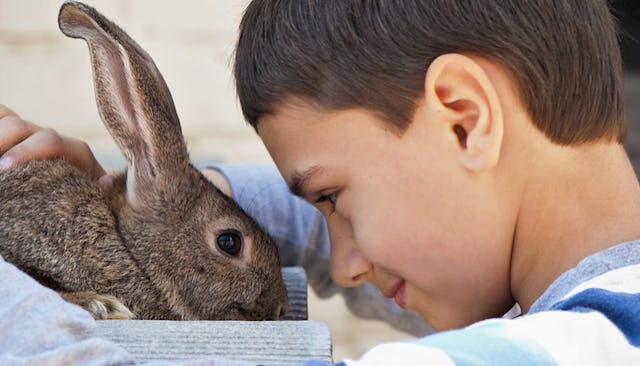How To Teach Our Kids To Be Kind To Animals

Train your children from their earliest days to be infinitely tender and loving to animals. If an animal be sick, let the children try to heal it. If it be hungry, let them feed it. If thirsty, let them quench its thirst. If weary, let them see that it rests. —`Abdu’l-Bahá
RELATED: 105 Kindness Quotes That Will Remind You To Be A Good Human
This quote from the Baha’í writings is one that our family has memorized and internalized as our kids have grown up. From the time they were tiny tots, we’ve encouraged our children to respect animals and their habitats and taught them to interact gently with creatures large and small.
It’s easy to think that kids will naturally be kind to animals without having to be taught, but that’s not necessarily true. Some kids don’t have an instinct for being gentle, and not all kids have peers who set good examples.
It’s not something we want to ignore, as there are some disturbing connections between kids who are cruel to animals and violent behavior towards people. (Whether one leads to the other or whether they’re symptoms of the same issue is up for debate, but the connection is there.)
Teaching compassion for creatures can help kids develop empathy for all living things, including their fellow human beings. And encouraging respect for animal habitats is an important part of teaching kids about protecting the environment.
Here are some specific ways to teach your kids to be kind to animals:
Pet the Right Way
“Gentle” is a word parents need to repeat ad nauseum when it comes to animals. Some kids will naturally use a soft touch, while others will want to grab or pinch or pull. Teach your kids to pet furry animals in the direction their hair goes and to avoid touching sensitive areas.
No Pulling Tails
Tails are tempting for toddlers especially. Remind little ones that even though tails look like they’d be fun to grab, they’re not handles. Keep the message simple for wee ones: “No pulling. Gentle touch.”
No Hitting
This should go without saying, but little kids can sometimes get a little vigorous with their “patting.” Again, use “gentle touch,” and show them how it’s done.
No Taunting
As kids get older, they will internalize the gentle touch idea, but they may not understand that you can upset an animal without touching them. Never throw anything at an animal, never yell in their face, or try to startle them. Some kids think it’s funny to spook a cat or dog, and they need to know that it’s not fun for the animal (and could be dangerous for them).
Learn an Animal’s Discomfort Signals and Respect Them
Teach kids that animals who are scared will try to protect themselves. If an animal is trying to get away, let it go. Don’t chase after it, even if you want it to come back.
Hissing and growling are obvious signs that an animal is upset or scared. Show them the body language that dogs and cats (or other animals they might be around) can give as warning signs. Explain that the Golden Rule applies to animals as much as it does humans.
Observe Wild Animals Without Touching
Take some time in nature — even just in your own yard — to observe the wildlife. Look under rocks to find centipedes or pill bugs. Watch how squirrels interact with one another. Sit very still and see what birds or butterflies land nearby. It’s wonderful to watch animals in the wild, and a good opportunity for young kids to exercise self-restraint.
Be Respectful of Habitats and the Environment
Explain to young kids that the outdoors is home to hordes of wildlife, some of which we don’t even see. Part of caring for animals is caring for their home. When we leave garbage laying around or break down trees or bushes, we are hurting their home. Tying earth-friendly actions to the welfare of our animal friends helps when environmental issues such as climate change are too abstract.
Visit Wildlife Refuges
I would include some zoos here, too, depending on the nature and purpose of them. (Not all zoos are terrible prisons for wild animals. Many are rehabilitative or shelters for animals that would not survive in the wild.) But wildlife centers are great places to get up close with wild animals and learn more about how to protect them.
Learn, Learn, Learn
My kids love Wild Kratts, a kids’ show all about animals. It’s fun, entertaining, and incredibly educational. My 5-year-old informed me that blue jays hide acorns just like squirrels do. I had no idea. Between documentary shows on Netflix and books from the library, our kids have a much greater knowledge and appreciation for a wider array of animals than I even knew existed when I was their ages.
Kids need to learn to care for creatures that are smaller and weaker — as well as larger and stronger — than they are. Respect for wildlife and kindness to animals are gifts our children will carry throughout their lives.
This article was originally published on